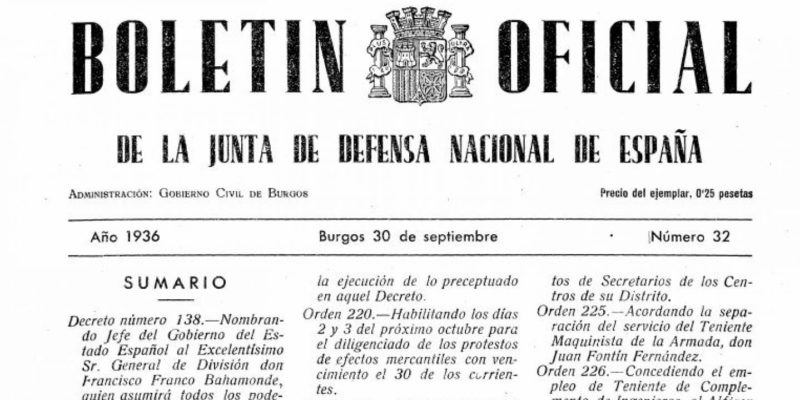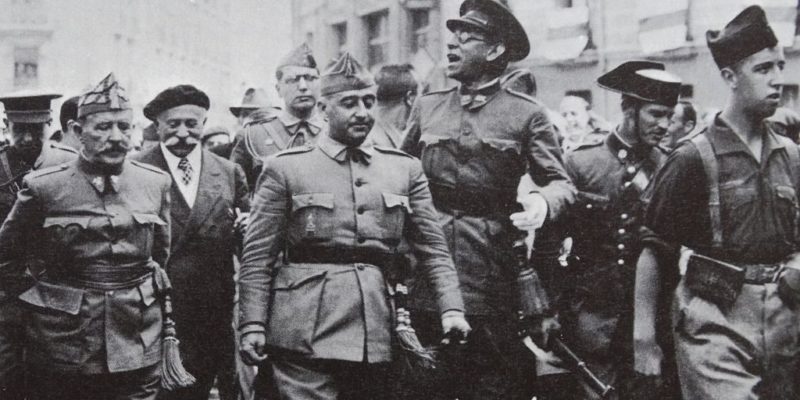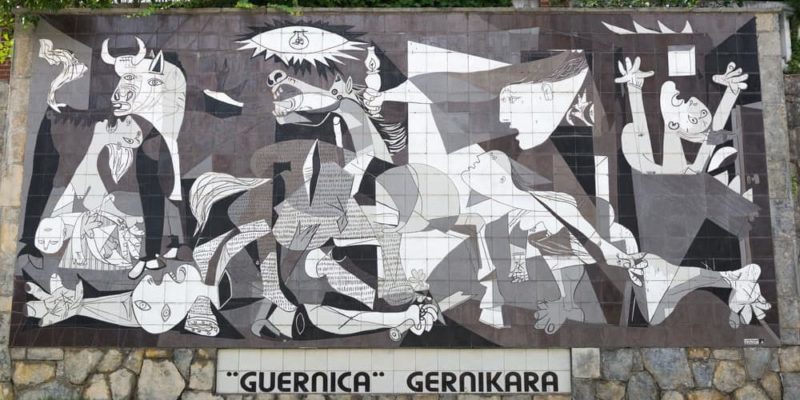We explain what the Spanish Civil War was and what its causes and consequences were. In addition, its characteristics and the role of the Church.
What was the Spanish Civil War?
It is known as the Spanish Civil War or also the War of Spain to a war that took place in that country between July 17, 1936 and April 1, 1939 . He faced the legitimately constituted government of the Second Spanish Republic, against various factions of the insurgent Spanish army.
The Spanish Civil War was a complex episode in Spanish history, in which very different models of country, government and national culture were opposed: conservatives versus liberals , military dictatorship versus democracy , fascism versus communism and anarchism , Catholic culture versus atheism , and also an intense class struggle.
Violence from both sides claimed numerous lives during the confrontation . However, when it ended with the victory of the insurgent side, a climate of reciprocal hatred was sustained.
The military insurgents were led by General Francisco Franco , who after winning the battle became leader and dictator of Spain until his death in 1975. Under his government there was an atrocious hunt for anything that was suspected of leftist militancy or values. Supposedly anti-Christian.
Occurred as a prelude to World War II , the Spanish Civil War represented one of the most tragic war events in European history in the first half of the 20th century . Around 500,000 lives were lost in it and the country was subjected to a fierce and conservative regime that lasted 36 years.
Background of the Spanish Civil War

At the beginning of the 20th century, Spain was emerging from a disastrous monarchical dictatorship that culminated in the resignation of Alfonso XIII.
The slow transition to democracy (known as the "dictablanda") was led by Admiral Juan Bautista Aznar.
In the 1931 elections, the left-wing parties were elected and the Second Spanish Republic was proclaimed.
This government approved, during its first biennium, a new Constitution and undertook a series of social and economic reforms .
The privileged sectors, seeing their interests affected, began a resistance to the Republican government. They organized, albeit unsuccessfully, a coup in 1932.
As paradoxical as it may seem, from the most radical segment of the political left there were also uprisings against the Republic . This is because they considered it an extension of the bourgeois order, and therefore contrary to their desire for social and political revolution.
This instability led to new elections in 1933 , the first in which women voted in Spain, and in which a right-wing republican coalition was elected, without monarchist intentions.
Anarchists and communists launched the October Revolution in 1934 . It was a series of socialist strikes against the elected government.
These protests contributed to the fear of conservative sectors of suffering a fate similar to that of the Soviet Union . This fear had spread rapidly throughout Europe after the Russian Revolution and was one of the factors used by fascism to legitimize its ideology and violent practices.
Causes of the Spanish Civil War
The causes of the conflict can be summarized as:
- The tense climate of political polarization and weakening of democracy due to political violence from conservative and ultra-revolutionary sectors.
- The victory of the Popular Front in the 1936 elections, inaugurating a government that removed the anti-republican military from power and that tried to resume the path of reforms that had already begun.
- The military conspiracy and coup d'état of July 1936, in which 70% of the armed forces rose up against the republican government.
Opposing groups

Two irreconcilably opposed factions clashed:
- The Republican side . Composed of sectors loyal to the constitutional government, led by the Popular Front: a coalition of republican parties added to the Spanish Socialist Workers' Party and anarchist sectors, trade unionists and a small communist movement. The peasantry, the proletariat and the Basque and Catalan autonomous movements were on this side.
- The rebel side. The self-styled “national side” was organized around the military high command, which made up the National Defense Board and was chaired by Generalissimo Francisco Franco, appointed Head of State of insurgent Spain. This faction was made up of conservative political movements such as the Spanish Falange, the Spanish Confederation of Autonomous Rights (CEDA), among others, and had the support of the Catholic Church and business elites.
International situation
When the conflict broke out openly in Spain, the international European powers were forced to assume an ideological position .
The most powerful Western democracies ( France and England ) assumed a cautious neutrality. In contrast, the already ruling forces of Italian and German fascism , Benito Mussolini and Adolf Hitler , openly supported Franco .
The fascist alliance was not just a political gesture. In addition, they provided troops that had an enormous impact on the war , such as the tragic bombing of the town of Guernica by German and Italian aircraft. Portugal, under the command of Anónio de Oliveira Salazar, also supported the insurgents.
On the other side, the USSR and Mexico supported the republican forces politically, diplomatically and militarily. They were also supported by an international coalition of European communist parties , enlisted under the name of the International Brigades.
Other countries such as Argentina and France collaborated with the evacuation of isolated troops and the adoption of exiles, as the conflict favored the Francoist side.
The National Defense Board

After overthrowing the republican government, and in the midst of hostilities, the rebellious side decided to organize its forces in a National Defense Board. The aim was to make the Popular Front party and unions illegal. In addition, it prohibited any form of labor or trade unionist political demonstration.
At the end of 1936, after Francisco Franco's victory in conquering Toledo, the Junta found the opportunity to achieve its long-awaited sole military command . That is why he named Francisco Franco Generalissimo of the rebel army and Head of the State Government.
The role of the Catholic Church
When the conservative military forces dealt the death blow to the Republic , the ecclesiastical institutions played an openly favorable role for them. The Church proclaimed their struggle as a “crusade for religion, country and civilization” , as the Bishop of Salamanca, Enrique Pla y Deniel, called it in one of his pastorals.
Thus, not only did the Church serve as an ideological and propagandistic ally of Francoism , but also as a diplomatic ally. In fact, at the end of the war, Pope Pius XII congratulated Franco on his "Catholic victory."
The republican defeat

The military superiority of the rebels became noticeable above the Republican ranks, divided between political factions and lacking in war experience . In 1936 the nationalists had advanced on Madrid and subjected it to a siege, without being able to conquer the university zone.
During the summer of the following year the Basque provinces and then Asturias complained . After capturing Teruel and gaining access to the Mediterranean in 1938, the Francoists managed to divide the Republic in two. Thus, the enemy troops were cut off.
Then began a war of attrition that claimed famine, misery and thousands of lives. At the end of that year they advanced on Catalonia, forcing the Republican troops into exile in France.
At the beginning of 1939 the Republican forces were in disarray , in exile, or in the process of surrendering. The Francoists entered Madrid at the end of March and on April 1 the war was over.
Consequences of the Spanish Civil War
The main consequences of the conflict were:
- The establishment of Francoism, a military, nationalist and Catholic dictatorship under the command of Franco, who persecuted and tortured his opponents for decades.
- The loss of thousands of lives, between military casualties on both sides and summary executions in the rearguards of both sides. Among the most famous deaths of the fascist side are those of artists and intellectuals such as Federico García Lorca.
- The exile of thousands of Spaniards who fled the conflict or the dictatorship that followed.
- The destruction and devastation of Spain, which prevented it from participating in the Second World War and thus return the favors received from its Nazi and fascist allies.
Francoism

The Franco regime began with the end of the Spanish Civil War and lasted until the death of the caudillo in 1975: almost forty years of fierce military dictatorship. In it, Catholic and conservative values were the norm and those who moved away from them deserved punishment.
Spanish was imposed as a compulsory language for the Basque, Galician and Catalan communities , prohibiting the use of their traditional languages and eliminating any hint of autonomy. Spain was once again one under Franco's boot.
Presence in culture

Numerous literary, film and artistic works have portrayed the horror of the Spanish Civil War. Among them we can highlight:
- The paintings Guernica by Pablo Picasso, The Mercury Fountain by Alexander Calder and the Catalan Peasant in Rebellion by Joan Miró.
- The films Bicycles are for the summer (1984) by Jaime Chávarri; Ay Carmela! (1990) by Carlos Saura, The Language of the Butterflies (1999) by José Luis Cuerda or The Devil's Backbone (2001) by Guillermo del Toro.
- The literary works For Whom the Bell Tolls by Ernest Hemingway, Soldiers of Salamina by Javier Cercas or The Wall by Jean Paul Sartre.
MA student of the TransAtlantic Masters program at UNC-Chapel Hill. Political Science with a focus on European Studies. Expressed ideas are open to revision. He not only covers Technical articles but also has skills in the fields of SEO, graphics, web development and coding. .
Leave a reply
Your email address will not be published. Required fields are marked *Recent post

Sport: What Is It, Types, Risks, Features, Characteristics and Examples

Dogs: Emergence, Features, Characteristics, Feeding and Breeds

Story: Definition, Elements, Structure, Features and Characteristics

